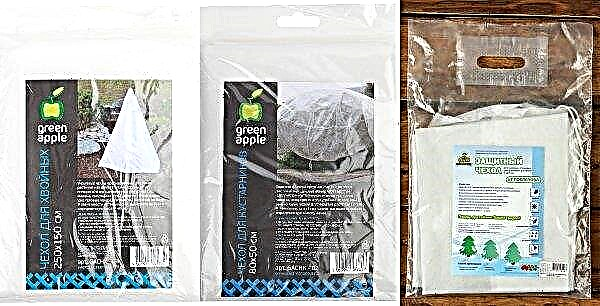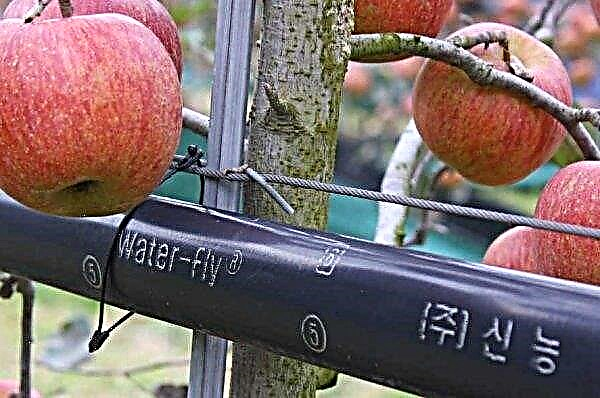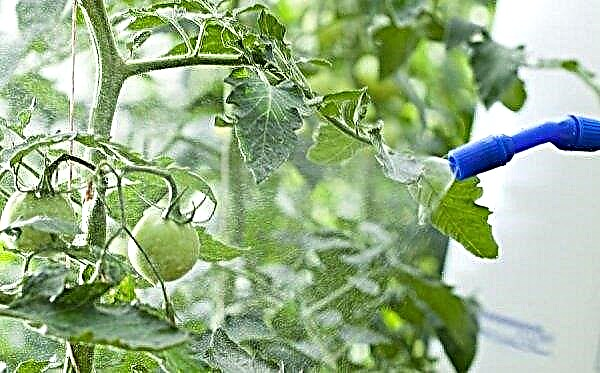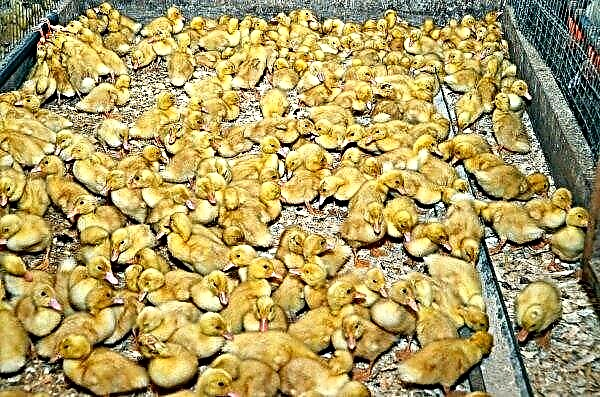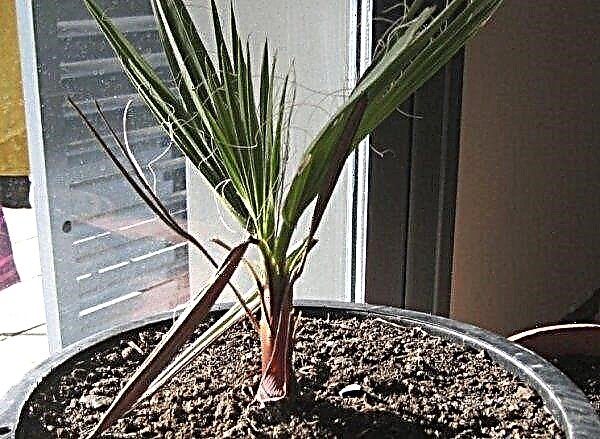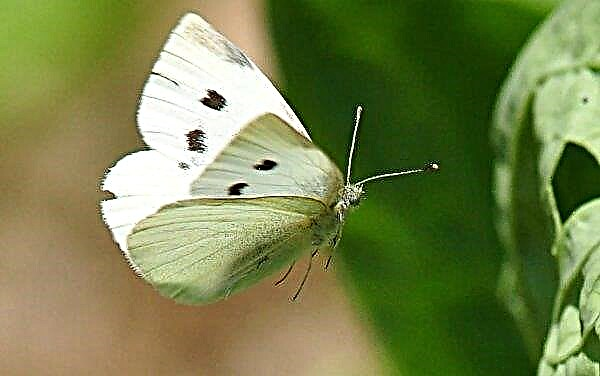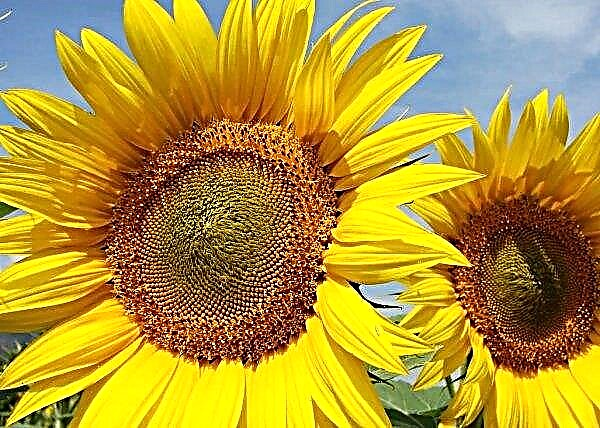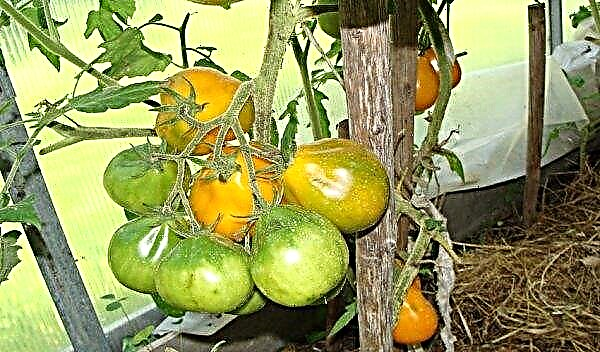Thuja western Miriam is the most modern of the recently bred coniferous varieties in Europe. The article provides a description of the tree, caring for it and the possibility of using it in landscape design.
Grade description
This variety was cultivated from Thuja occidentalis Danica and took from it all the best with regard to shape and appearance. The thuja, which looks like a ball, has rich yellow-green needles that grow up. In winter, its shade becomes more like bronze, but in spring the green color gives yellow. The plant grows less than 0.8 m both in height and in breadth. It grows slowly, about 5-10 cm per year.

The root system is very sensitive to compaction and is located close to the ground. The plant is very photophilous, but can grow in partial shade. In a shady place, the needles will lose their bright shade and begin to dry out. For this type of coniferous soil with moderate humidity is suitable.
Did you know? In traditional Chinese medicine, the leaves and stems of East Thuja are used to treat nervous disorders, insomnia, heart palpitations, as well as to stop bleeding and fever.
In landscape design
Thuja of this species is often used in landscape design. You can use a tree that grows in a pot or plant it in open ground.
In a pot
Trees that are planted in pots are great for decorating lawns. You can often find tanks with Miriam thuja on balconies, terraces and roofs of houses.
In the open ground
The plant, planted in open ground, fits perfectly into the city panorama, so it can often be seen on paths along streets or squares. This type of coniferous stands out in various flower beds and is an ornament of borders. It is also used to form live fences.

Songs
Due to the fact that the thuja Miriam grows slowly and remains unchanged for a long period, gardeners often use it to decorate Japanese gardens and alpine hills, as well as for compositions that use trees and shrubs with different structures and colors.
Landing
It is necessary to choose a seedling for planting in specialized stores or nurseries. It is necessary to pay attention so that traces of damage from pests and rot are not visible on the plant. The roots were strong and ready for transplanting. It is very important for the tree to grow well to choose the place where it will grow. For thuja Miriam, light areas with slightly acidic soil are best suited.

In the pot
To plant a seedling in a pot, it is recommended:
- When choosing the containers in which the plant will grow, you need to pay attention to the root system. It should occupy no more than 1/3 of the volume of the pot.
- It is necessary to plant a sapling together with the soil that has accumulated on the roots.
- The tank must have good drainage so that the water does not stagnate and does not harm the roots.
- For drainage, you can use pieces of polystyrene or gravel. If gravel is used, then the tank will be very heavy.
- Put the seedling in the pot. The neck of the roots should remain at ground level.
- To water.
- Place in a permanent place of stay.
Did you know? In 2002, scientists from Germany announced that infusion based on needles of thuja, alcohol and water reduces the spread of type A influenza virus.
In open ground
For planting in open ground it is recommended:
- Dig a hole in which the root system of the seedling will fit together with an earthen lump.
- Install a drainage layer. For this, you can use parts of broken bricks.
- Place the seedling in the pit.
- Prepare the soil with which the root of the plant will fall asleep. To do this, you need land with leaves, sand and peat. Combine the components in a 2: 1: 1 ratio.
- Having fallen asleep the seedling root with prepared soil to the root neck, you need to water it and mulch with elderberry or thuja leaves. 3-5 liters of water are sufficient for irrigation.

Care
In order for the thuja Miriam to grow healthy and not lose its appearance, you need to take care of it. She needs the correct watering, top dressing and pruning, as well as preparation for wintering.
Watering and feeding
The plant needs to be watered regularly. This is especially true for newly planted seedlings, which can become sick if the soil begins to dry out. About 10 liters of water are needed per planted tree. You need to water once every three days, but do not forget to take into account weather conditions. In dry weather, it is additionally recommended to turn on automatic water sprayers. Turn them on best after the sun goes down. This is done so as not to provoke possible sunburn of needles.
Important! Humus, manure and urea are not used for fertilizing thuja western Miriam.
To feed a tree begin in April - May. To do this, use complex nutritional compositions, for example, Kemira universal. On 1 m² of the trunk circle, 50 g of the drug is needed. In the fall (end of September - October), potassium-containing products are added to the soil.

Wintering
It is necessary to prepare a tree for winter frosts around October - November. To do this, you must:
- tie the crown with a rope or ribbon made of fabric;
- wrap with specially designed material that will play the role of insulation (agrospan, spanbond, lutrasil, kraft paper);
- to protect the seedling from blockages of snow, you can make an awning from a film that is pulled on top of sticks made of wood or other materials;
- strengthen the canopy so that it can withstand strong winds;
- the soil around the trunk must be insulated. For this, sawdust and needles are used, laying spruce branches on top.

Disease and Pest Prevention
Pests that can damage the plant and how to deal with them:
- aphid. It destroys part of the branches that are closer to the trunk. To destroy it, you need to spray the plant with Karbofos;

- speckled moth. This species of butterflies destroys whole plantings of thuja. She is more active in the summer. A sign of the appearance of a moth is the brown upper parts of the needles and drying branches. You can fight it with the help of substances containing pyrethroids. It is necessary to spray for 3 weeks with an interval of 7 days;

- false shield. To eliminate this insect, it is necessary to spray the tree with Karbofos and Aktellik;

- nutcracker. Its larvae develop in acidic soils and in the presence of a large amount of water. They damage the roots of the plant, because of which it can die. In the fight against them, substances based on Diazonin will help.

Important! A good drainage layer and digging in the fall helps to get rid of pests.
Diseases that are characteristic of the plant and ways to deal with them:
- fungus. A sign of damage to the disease is the brown color of the branches. Shoots that have been infected are removed with a secateurs and destroyed. Lime is added to the earth around the trunk and sprayed with a 0.2% Fundazole solution once every 14 days. The procedure is repeated 2-3 times;

- soil mushrooms. They damage the root system of the tree. For prophylaxis, the plant is sprayed with Zircon, which develops resistance to the disease, and fungicides Khom, Kartotsid. It is necessary to dissolve 40 g of one of the drugs in 10 l of water. Spray all summer months every 2 weeks;

- drying out branches. So that the branches do not dry, you need to treat them with preparations that contain copper. For example, fungicides.

Cropping and shaping
To needles were beautiful and fluffy, every year you need to cut the shoots for prevention. In early April, branches with damage or with traces of freezing are removed. At the same time, the so-called forming pruning is carried out. As a rule, the crown is sheared in the shape of a ball or hemisphere. But in any case, you yourself choose what you like.

Planting thuja western Miriam and caring for it will not be difficult, even for amateur gardeners. This small tree fits perfectly into any space and helps to emphasize the beneficial aspects of plants that are planted nearby.








